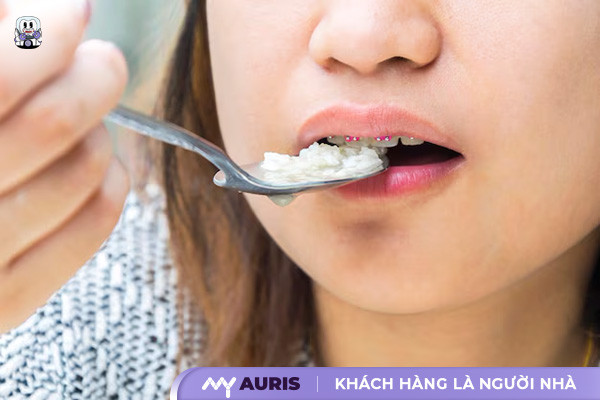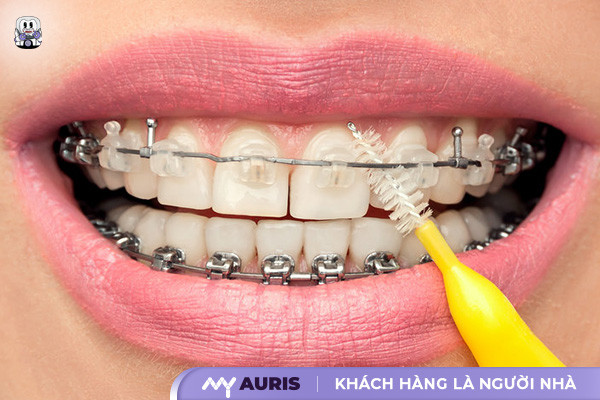Braces help you achieve a beautiful smile, but they require a special diet. My Auris Dental shares foods to avoid for effective and pain-free orthodontic treatment. Let’s learn how to protect your oral health.
The Importance of Diet During Braces
Proper eating during orthodontic treatment is not just about choosing the right products. It is a key factor that determines the success of the entire process. The food consumed, how it’s chewed, and how the teeth are cared for directly impact overall oral health, the speed of tooth movement, and the final result.
Nutrition for Teeth and Body: During tooth movement, the body needs sufficient nutrients to support jaw bone restructuring and tooth movement. A balanced diet, rich in vitamins and minerals, helps keep teeth healthy, reduces the risk of cavities and other oral diseases. Foods rich in calcium, protein, and vitamin D are especially important.
Protecting your Orthodontic Appliance: Brackets and archwires are easily damaged by hard, chewy foods. Eating correctly helps protect the appliance, preventing detachment, breakage, and ensuring the treatment process is efficient, saving time and cost.
Reducing Pain and Discomfort: After braces are placed, teeth may feel sore, painful, and sensitive. Prioritizing soft, easy-to-chew foods helps reduce pressure on teeth, minimizes pain and discomfort, and helps you adapt faster to your braces.
Easier Oral Hygiene: Food easily gets trapped in braces, creating a favorable environment for bacteria to grow, leading to cavities and other oral problems. Choosing foods that are easy to clean, combined with proper oral care, helps prevent these issues.

What Should People New to Braces Eat?
When you first get braces, your mouth often hasn’t adapted to the orthodontic appliances, making your lips, tongue, and jaw sensitive, which can interfere with daily activities. Therefore, establishing a suitable diet is essential to support oral health and minimize discomfort. Below are groups of soft, easy-to-eat, nutritious foods recommended for those new to braces:
Soft, Cooked Foods
In the first few days of wearing braces, prioritize liquid or soft dishes like porridge, soup, vermicelli (bún), and pho. These dishes don’t require much chewing force, thus reducing pressure on the teeth being adjusted. Additionally, they provide sufficient energy and nutrients, helping the body avoid fatigue.
Vegetables, Roots, and Fruits
Green vegetables, roots, and fruits contain many vitamins and fiber, helping to boost immunity and reduce fatigue, especially when teeth are sore. You can prepare them as smoothies or juices for easier consumption and quicker absorption.
Nutritional Grains
Nutritional grains such as tofu, soft sandwiches, oatmeal, etc., are ideal choices for breakfast or snacks. They are easy to chew and provide a rich source of carbohydrates, helping you maintain energy throughout the day without putting pressure on your jaw.
Milk and Dairy Products
Milk, yogurt, cheese, and milk cakes are excellent choices for those new to braces. These products are easily digestible and provide calcium – an important factor for strong teeth throughout the orthodontic treatment process.
Eggs and Egg Dishes
Eggs, flan, sponge cake, etc., contain a lot of vitamin D, which supports calcium absorption and protects teeth. These egg-based dishes are not only easy to eat but also suitable for those who have difficulty chewing after their orthodontic appliances are fitted.
Meat, Seafood
Meat and seafood are essential sources of protein, helping to maintain weight and support muscles during orthodontic treatment. If chewing is difficult, cut them into small pieces, mince them, or blend them finely to cook with porridge or soup, ensuring they are easy to eat and retain their nutritional value.
What Foods Should You Avoid During Braces to Shorten Treatment Time?
When undergoing orthodontic treatment, it’s not only important to adjust your diet appropriately but also crucial to understand what foods to avoid. This is because maintaining unsuitable eating habits can inadvertently damage your braces, prolong treatment time, and reduce the effectiveness of the braces.
So, what shouldn’t you eat with braces? Here is a list of foods you should avoid to protect your teeth and braces throughout the treatment process:
Very hard foods: Items like hard candies, ice cubes, chestnuts, etc., require strong chewing force and can cause brackets to detach or archwires to bend.
Chewy and sticky foods: Sticky rice cakes (bánh nếp), thick glutinous rice cakes (bánh dày), grilled octopus, grilled ribs, etc., are not only difficult to chew but also easily get stuck in braces, potentially causing gum inflammation.
Foods that are too hot or too cold: Hot pot, boiling water, ice cream, shaved ice, etc., can cause sensitivity, affect tooth sensation, and prolong orthodontic treatment.
Foods that need to be bitten or torn: Such as chicken feet, cartilage, enoki mushrooms, etc., can easily put pressure on teeth that are moving.
Dark-colored foods: If you have ceramic braces, you should avoid foods like curry, soy sauce, coffee, etc., as they can easily stain the brackets, affecting aesthetics.

Proper Chewing Techniques with Braces
Step 1: Cut Food into Small Pieces
Cutting food into small pieces before putting it into your mouth is an important step. Large pieces of food put pressure on the braces, weakening and causing pain to the teeth, and can even dislodge brackets. Cutting food into small, manageable pieces makes the chewing process easier, reduces pressure on the teeth, and minimizes discomfort. For example: cut meat into small pieces, break bread into bite-sized portions, and hard fruits should be cut small or pureed. This helps protect your braces and archwires, reducing discomfort and pain. Dentists encourage patients to pay attention to this step to ensure smooth treatment.
Step 2: Chew with Your Back Teeth
Chewing with your back teeth helps distribute force evenly, avoiding direct impact on your front teeth and braces. Your molars are designed to grind food, aiding in nutrient absorption. Chewing with your front teeth puts excessive pressure, which can easily lead to detachment or poking. Focusing on chewing with your back teeth helps protect your appliance, reducing pain and discomfort. When you first get braces, it might feel difficult, but you will gradually get used to it. Commit to protecting your oral health and ensuring the effectiveness of your treatment.
Step 3: Eat Slowly and Chew Thoroughly
Eating slowly and chewing thoroughly is an important factor that helps the digestive system function well and absorb maximum nutrients. Thorough chewing makes food softer and easier to swallow, reducing the burden on the stomach. During treatment, eating slowly helps control chewing force, avoiding damage to teeth and braces. Thorough chewing also aids in oral hygiene by removing food debris stuck on braces, reducing the risk of cavities. Eating slowly and chewing thoroughly is a good habit for oral health, supporting the treatment process to achieve desired results.

Notes on Eating During Braces Treatment
Here are some important notes to help you eat comfortably and protect your oral health throughout your orthodontic treatment:
Focus on Oral Hygiene
Thorough oral hygiene after every meal is mandatory. Use a soft-bristled toothbrush, toothpaste, and dental floss to clean between teeth and around braces. Mouthwash also helps remove bacteria and plaque, providing a clean, comfortable feeling. Don’t forget to visit your dentist regularly for scheduled check-ups and timely adjustments.
Cut Food into Small Pieces
Cutting food into small, bite-sized pieces helps you chew more easily, reducing pressure on your teeth and braces. Avoid biting or tearing food directly with your front teeth, especially hard or chewy foods. Chewing thoroughly with your back teeth helps grind food into smaller pieces, making it easier to digest and minimizing the chance of it getting stuck in your braces.
Choose Appropriate Foods
Prioritize soft, easy-to-chew foods such as soup, porridge, boiled vegetables, minced meat, and soft fruits. Limit hard, chewy, sticky foods like hard candies, dry bread, and nuts. Carbonated drinks and soft drinks should also be limited due to their high acidity, which can erode tooth enamel. Increase your intake of calcium-rich foods, vitamin D, and other nutrients to support oral health.
Be Patient and Listen to Your Body
During the initial period of wearing braces, you may experience discomfort and soreness. This is normal. Be patient and listen to your body. Eat slowly, chew thoroughly, and choose soft, easily digestible foods. If you encounter any problems, please contact your dentist for advice and support.
By following these guidelines, you can overcome the initial difficult phase, enjoy the orthodontic treatment comfortably, and achieve your desired results. A beautiful, aligned set of teeth and a confident smile await you!
FAQs About Diet During Braces
Wearing braces changes your dental arch, affecting how you eat. Many people worry about their diet and what they can eat. Here are some frequently asked questions to help you build a suitable menu.
What Fruit Juices Should You Drink with Braces?
Fruit juices provide vitamins and minerals to the body, but caution is needed when wearing braces. Choose low-sugar juices and avoid highly acidic juices like orange and lemon, as they can erode tooth enamel. It’s best to drink apple, pear, or watermelon juice. Drinking plain water remains the best choice for oral health. After drinking juice, rinse your mouth thoroughly with water or specialized mouthwash.
Can You Eat Candy with Braces?
Candies, especially hard candies, gummy candies, and caramel, should be avoided when wearing braces. Their stickiness and hardness can easily get stuck in braces, making cleaning difficult, leading to cavities, and damaging the braces. If you crave sweets, choose soft fruits like bananas or avocados.
Can You Eat Ice Cream with Braces?
Cold ice cream can cause sensitivity if your teeth are weak. Furthermore, ice cream often contains a lot of sugar, which is not good for oral health, especially with braces. If you eat ice cream, choose a low-sugar type, eat it slowly, and then clean your mouth thoroughly.





